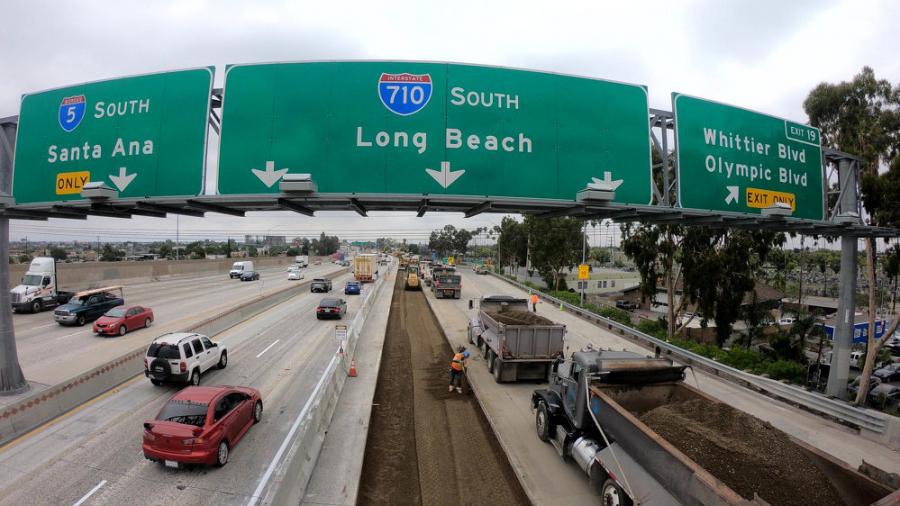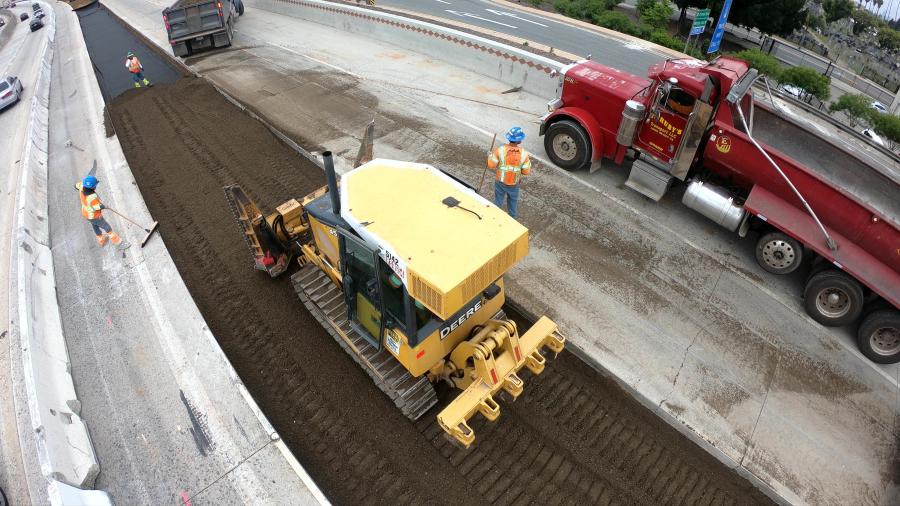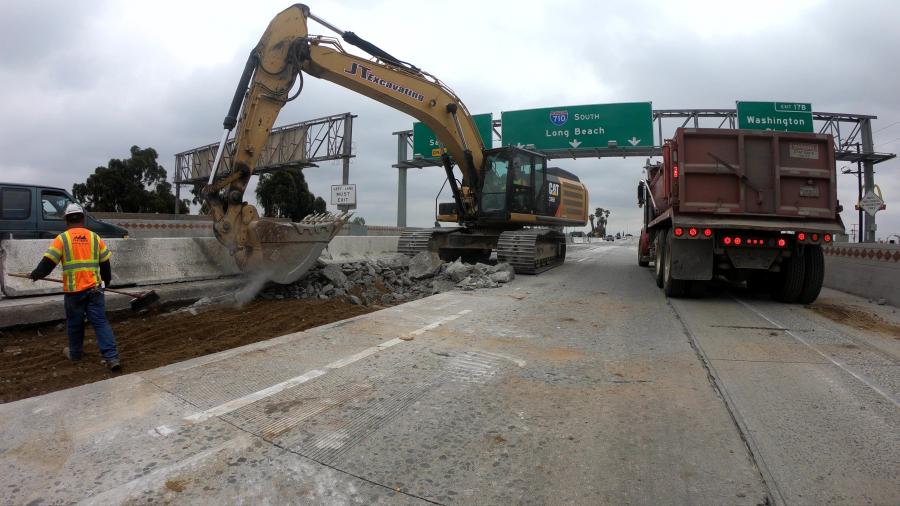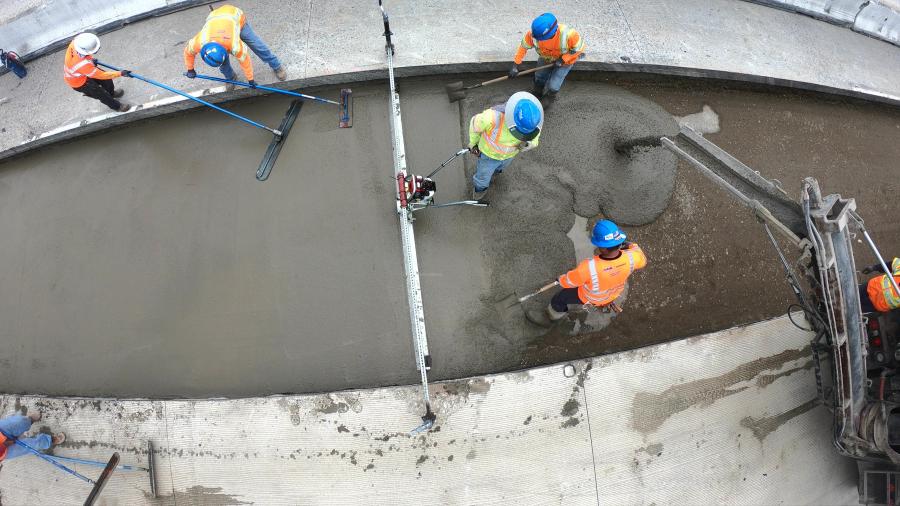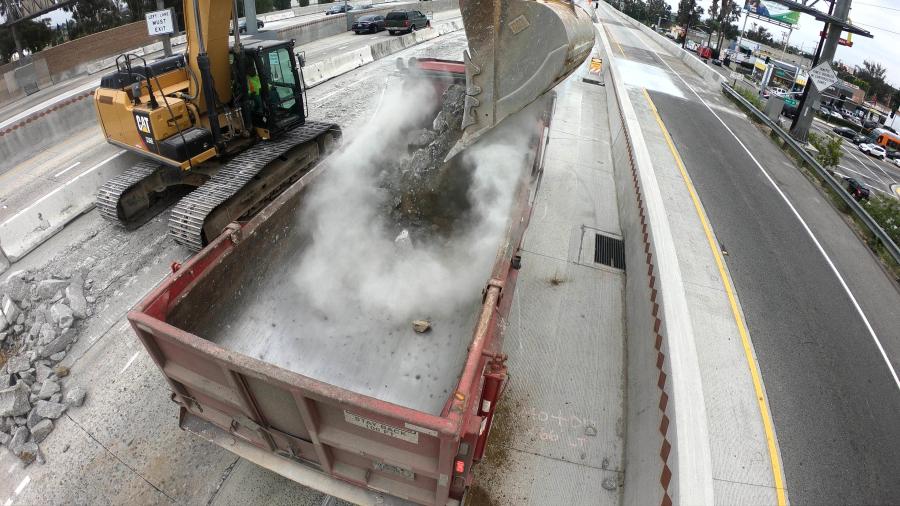During weekend closures, Flatiron vehicles are able to enter and exit the work zone.
Construction began in May 2018 on the California Department of Transportation's (Caltrans) $150.7 million Interstate 710 Pavement Rehabilitation and Bridge Widening Project, which was awarded to Flatiron Construction Corporation in February 2018.
Crews have been making solid progress on the project that covers a 3.5-mi. stretch of the north-south I-710 through the cities of Commerce, Vernon, Bell, and the unincorporated area of East Los Angeles from Slauson Ave. to State Route 60. The project, financed by state and federal dollars, is scheduled to be completed in 2021.
Rehabilitation
The project consists of rehabilitating a portion of the highway (five lanes in each direction) with joint plain concrete pavement, (JPCP), and continuously reinforced concrete pavement (CRCP). All northbound lanes between Bandini Boulvard and the I-5/I-710 Interchange are being replaced with JPCP. The Hobart Yard Bridge, which spans BNSF16 rail tracks and several Metro lanes, is being widened.
The highway has five non-standard lanes (11 ft.) in each direction and is being widened to five standard lanes (12 ft.) with 8-ft. wide shoulders (inside and outside). In addition, the median shoulders are being repaved with JPCP and the median barrier will be upgraded to meet current standards. The work also includes installing new overhead sign structures, an overhead changeable message sign, and upgrades to drainage.
Caltrans wants the project completed rapidly and crews are working non-stop, seven days a week, with road closures occurring between 7 p.m. and 6 a.m. for 24 weekends (16 thus far); 55-hour closures are invoked.
The Hobart Yard Bridge at 1,200 ft. is the longest, while the Bandini, Washington, and Pacific Way bridges are shorter. The on/off ramps for the bridges also are being widened.
"The Bandini, Washington, and Pacific Way bridges are most utilized by trucking," said Peter Lee, Disrict 7 resident engineer.
Approximately 37 lane miles will be replaced, which includes all lanes of I-710 from Slauson to SR 60.
"The project will reduce congestion," said Eric Menjivar, public information officer of Caltrans District 7. "With the shoulders, motorists in an emergency will have a safe place to pull over and backups will not occur. It also provides a safe place for the California Highway Patrol and Caltrans maintenance workers to do their jobs. It will improve the movement of goods into and out of the Port of Los Angeles and the rail yards, creating a smooth transition for trailers where there is no interruption for them and motorists."
Planning for the initiative began in 1999. The infrastructure was built in the 1960s and upgrades are needed to extend the lifespan.
Prior to construction, the highway carried 214,000 cars and trucks daily. When completed, the new infrastructure will be able to handle 230,000 vehicles and meet traffic demands for the next two decades.
New Infrastructure
In-house Caltrans engineers designed the new infrastructure.
"The biggest challenge is widening the Hobart Yard Bridge over the rail yard," said Lee. "We're also rehabilitating the old concrete pavement, which is being done on weekends from Friday night to Monday morning, reducing traffic to two lanes. We're using a fast setting concrete, with a polyester concrete overlay, that sets in 12 hours. With conventional concrete, we could not put traffic on for at least 10 days. Normally the concrete pavement is 9-to-10 in. thick, but we're putting in over 13 in. — a thicker, beefier pavement because a lot of trucks use the highway."
The existing drainage system is being extended to the areas being widened with reinforced concrete pipe and drainage inlet, along with a Gross Solids Removal Device system (GSRD) to filter out the debris from the runoff before it goes into the channel adjacent to the Washington Bridge. A minimum amount of landscaping using drought tolerant foliage will be done when feasible.
Local traffic is impacted due to lane closures.
"Since the start of construction, extended closure signs have been posted at the start and end of the construction zone," said Menjivar. "Signs alerting drivers that there may be temporary closures are also at every ramp in the construction zone. Electronic changeable message signs with detour and closure information will be posted at various locations around the construction zone during construction hours."
Caltrans is extensively using social media to keep motorists updated on lane closures and detours.
Flatiron has completed nearly 90 percent of the bridge work, with the remainder taking place on the Hobart Yard Bridge. But a fair amount of the road work sill remains.
"We're about 70 percent complete," said Lee. "For the 2020 construction season, our goal is to finish all the weekend pavement work by May and finish the Hobart Yard Bridge work just before summer so the full weight of that bridge can be utilized. For the second half of the year, Flatiron will rebuild the median pavement sections and place a new median barrier. There will be some landscaping and hardscape improvements in 2021."
On Jan. 13, crews began the demolition of an overhang with an existing barrier on the Hobart Yard Bridge.
"We have to remove the existing overhang barrier and build a bridge deck closure pour to tie the existing structure together," said Lee. "We're coordinating with BNSF to secure the work windows where we can go in. A temporary platform is being built to help catch all the concrete rubble that will fall down so that it doesn't damage the tracks."
Mike Roe, Flatiron's project manager, also is dealing with the restrictions of a tight work zone and constant traffic.
"We try to provide a 30-and-40 ft. work zone for the crews," said Lee. "For the weekend closures, K rails are placed and for weeknights, cones are placed. We close the ramps on weekends and this is where crews access the work area and bring in construction materials."
Relations between Caltrans and Flatiron are excellent.
"We have a good team," said Lee. "Flatiron is a seasoned and experienced contractor in Southern California and we don't have any disputes as of today. We have developed great partnering relationship and trust in our team and the project is ahead of schedule. We also have weekly meetings with BNSF to coordinate the upcoming construction work."
Much of the lane reconstruction is done on weekends.
"We've learned a lot as the work has progressed because there is only so much that you can do on weekends," said Lee. "You cannot do more than you planned, because once you're committed, you have to finish what you started and the freeway closure has to be opened for the Monday morning commute."
Multiple crews remove the concrete and the soil beneath it, going down directly to the subgrade.
"It's a brand new roadway and that requires a lot of planning and coordinating," said Lee. "We stop paving on Sunday afternoon so that motorists can use the new lane on Monday morning. Because they excavate down 3 feet, the material they run into can be a bit tricky — claylike or soupy dirt and soil, which is a challenge for the crews."
Between 3,000 and 4,000 ft. of new lanes can be constructed on weekends.
One of the challenges for the Hobart Yard Bridge work are the CIDH — cast in drilled hole concrete foundations.
"These pilings are 80 feet deep and we're working on them next to train traffic," said Lee.
The drainage system is being installed as the new roads are being constructed.
"Last winter it rained more than previous years in Southern California and Flatiron had to provide many temporary drainage systems — channeling and diverting stormwater around the work area — while the new pipes, inlets, and GSRD were placed," said Lee.
Peak days have 80 Flatiron and subcontractor employees on site. The subcontractors are Statewide Traffic Safety & Signs; BC Traffic Specialist; CGO Construction Company; Advanced Concrete Sawing & Sealing; All American Asphalt; Ace Fence Company; Velarde Concrete Construction; Penhall Company; Griffith Company; Ferreira Construction; Don H. Mahaffey; Diversified Landscape Co.; Coral Construction Company; Cooper Engineering; Con-Fab California LLC; CMC Commercial Metals; LSM Transport; and Pre-Con Products.
What's Being Removed
Materials being removed include 30,000 cu. yds. of concrete, 3,000 tons of asphalt, and 5,000 tons of steel. New materials to be brought will see 40,000 cu. yds. of concrete, 10,000 tons of asphalt, and 10,000 tons of steel, and 30,000 cu. yds. of base materials.
Flatiron set up a batch plant at the Bandini Blvd. off-ramp in Vernon to produce concrete for the repaving, which is using concrete removed from the existing structures, barriers and pavement.
"In keeping with our efforts to enhance the environmental sustainability, concrete is being recycled and used for this and other construction projects," said Menjivar. "Residents and local businesses nearest to the freeway may notice noise, vibrations and dust associated with the batching operation. We're making every effort to mitigate noise associated with construction activities by installing a noise reduction barrier around the plant location."
Noise levels do not exceed state, federal and city regulations; water trucks are being used to minimize dust during working hours; and dump truck drivers are minimizing backing up operations to reduce back-up alarm noise.
What's Being Used
Flatiron is using a large amount of equipment, including: cranes — a Link-Belt RT-8065 and an RTC8080 SER II 80 ton RT, and Terex 75-ton RTs and a T-340-XL; backhoes — a John Deere 410G, and Cat 430Es and a Cat 430E; excavators — a Cat 308E2 CRSBs, M322Ds, 321Cs 328D, 330CLs; and 345Cs; rollers — a Bomag 3-5 ton DBL, a Cat CS563, and a Dynapac CA260D; air compressors — Ingersoll Rand 185s and 250s; light towers — I-R and Magnum; loaders — Cat 938G IIs, 950Hs, 950Gs, 950 HQs, and 950Ks; skidsteers — a Volvo MC 90 B, a John Deere 325 LDR, and a Cat 259D CCE; forklifts — Hyster H80FT 8Ks and H360HDs, XTREME 11Ks and 12Ks; paving equipment — an Air Screed 58LF, a Multiquip screed, GOMACO RTP - 500 placer. an E2 Systems converyer placer, Bidwell BR201s and 4800s, GOMACO 2800, 4000, and Commander III pavers, GOMACO T600 cure tnm machines; batch plants — a Rexcon and a Strayer M-11; volumetric mixer trucks — Mack/Global 10 yds. and Peterbilt 14s; a variety of Ford and Dodge trucks; and various Sterling, Ford, Dodge, Peterbilt, and Kenworth mechanics trucks.
Mechanics are on site to do rapid repairs to maximize the work hours.
Flatiron purchased and rented equipment from many regional Los Angeles dealerships, which are helping with the project by providing spare parts and servicing machine under warranty. CEG
Irwin Rapoport
A journalist who started his career at a weekly community newspaper, Irwin Rapoport has written about construction and architecture for more than 15 years, as well as a variety of other subjects, such as recycling, environmental issues, business supply chains, property development, pulp and paper, agriculture, solar power and energy, and education. Getting the story right and illustrating the hard work and professionalism that goes into completing road, bridge, and building projects is important to him. A key element of his construction articles is to provide readers with an opportunity to see how general contractors and departments of transportation complete their projects and address challenges so that lessons learned can be shared with a wider audience.
Rapoport has a BA in History and a Minor in Political Science from Concordia University. His hobbies include hiking, birding, cycling, reading, going to concerts and plays, hanging out with friends and family, and architecture. He is keen to one day write an MA thesis on military and economic planning by the Great Powers prior to the start of the First World War.
Read more from Irwin Rapoport here.
Today's top stories



